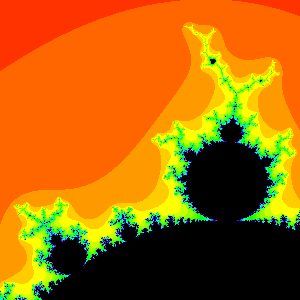


|
Question: How do you find the rotation number of the largest bulb that lies between two given adjacent, even larger primary bulbs?Answer: Amazingly, given two primary bulbs with no larger bulbs in between, you can find the rotation number of the largest bulb in between by adding the fractions "just the way you always wanted to add fractions" --- namely by adding the numerators and the denominators. Please do not do this in your math class... it's illegal everywhere except here!
|
|
Example 1:
|
|
|
Example 2: Here is another example. The largest visible bulbs in this magnification of the Mandelbrot set are the 2/5 bulb on the left and the 3/8 bulb on the right. In between sits the largest bulb which has rotation number 5/13. And again,
Isn't this great? But remember, if you ever do this in math class, you'll be in BIG trouble!
|
|
Exploration: Do you see the omnipresent Fibonacci sequence in the Mandelbrot set? As a hint, click here. Warning: This file is large --- 8 Mb --- and will take a while to download.
For Further Information: See the papers:
Dynamical Systems and Technology Project
Home Page